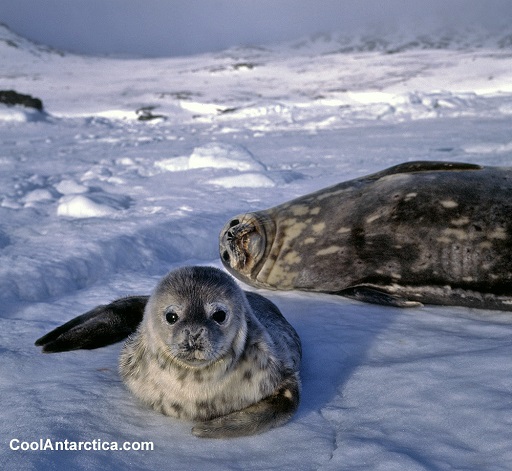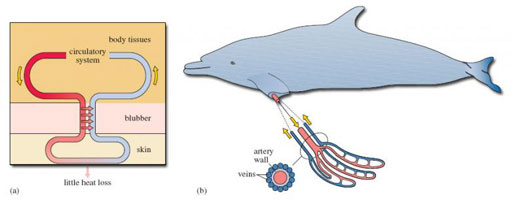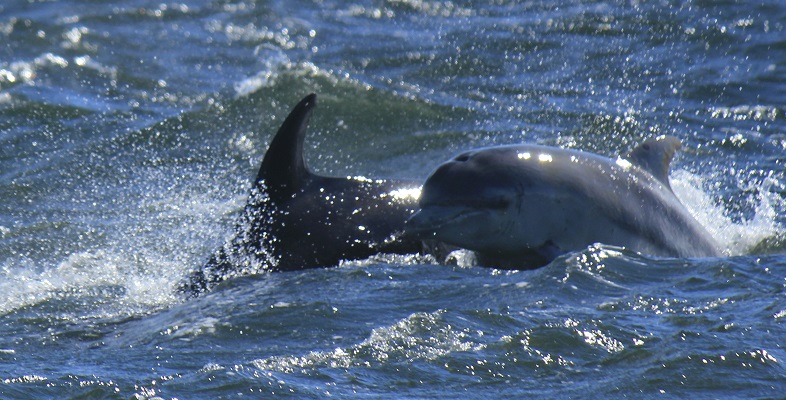2.4 Staying warm …
Water has a higher specific heat than air: that is, it takes more energy to raise the temperature of a particular volume of water than it does to raise the temperature of the same volume of air by the same amount. One consequence of this is that the temperature of surface water tends to fluctuate within a smaller range than air temperature: from −1.9 °C (the freezing temperature of seawater) near the poles to an extreme of about 30 °C in the tropics. But deep water is always cold, whatever the location in the ocean; below about 1000 m, the temperature is uniformly cold, about 3-4 °C. The risks of heat loss from an aquatic mammal are all the greater because water has a relatively high thermal conductivity, so a warmer object loses heat fairly quickly when immersed. Think of thermal conductivity simply as a measure of how readily heat flows from a particular material. Marine mammals, like many of the larger land mammals, maintain their body temperature somewhere between 35 °C and 38 °C, so they all face the problem of staying warm in a colder environment.
This section explained the term ‘thermal conductivity’ above as ‘a measure of how readily heat flows from a particular material’. In a course of this level and duration, there will not be a detailed explanation of how it is measured, or its actual values and units. You may like to do your own further research to learn more about this area.
To put this into context, consider the Weddell seal of Antarctica. It maintains an internal temperature of 37 °C, despite water temperatures of around 0 °C and air temperatures of 0 °C to −50 °C (with a wind chill down to −100 °C or so). The newborn pup is protected from the cold by a dense layer of fur called ‘lanugo’. In the first month or so of life, as it prepares to go to sea, the pup replaces its lanugo with the shorter, sparser hair of the adult seal and develops a thick layer of blubber.

Question 2
Can you think of a likely explanation for this change?
Answer
Blubber provides better insulation in the water (and the smoother coat of the adult improves its streamlining).
A fur coat traps a layer of warm air next to the body and is a fairly good insulator in air and water, but it has its limitations. It requires a lot of maintenance, and water pressure squeezes out the air if the animal travels too far below the surface. (It is the still air trapped by fur that provides the insulation; a trapped layer of water in fur would provide some insulation, but not nearly as much as that offered by air.) Otters and fur seals make relatively modest dives, but many cetaceans and true seals, like the Weddell seal, hunt in deeper, colder waters.
Animals that dive to any great depth stay warm using blubber, a thick layer of fatty tissue that extends far beneath the skin. In air, blubber provides less insulation than an equal thickness of fur, but it retains much of its effectiveness in water and the extra bulk is less important in the more supportive medium. You’ll appreciate the fact that the relatively high density of the surrounding water helps ‘buoy up’ aquatic animals, such that diving mammals weigh relatively little in water.

Those parts of the animal not covered in blubber – the limbs and parts of the head – have another device for retaining heat: a countercurrent heat exchange system. In Figure 9(a), the outgoing (i.e. arterial) blood is shown to the left, on its way to the skin surface. But en route, such vessels run very close to a network of veins that are bringing cool, venous blood back into the body (shown to the right in Figure 9(a). Given the proximity of the (warm) outgoing and (cooler) incoming bloods, heat (which would otherwise be lost through the skin) is taken up by the cooler returning blood and carried back inside the animal. The red arrows in Figure 9(a) show the direction of heat flow; there is comparatively little heat loss from the skin. If you think about it, the system depends on outgoing and incoming blood flowing in opposite directions, which is why it is called countercurrent heat exchange. If the two blood flows were in the same direction, there would cease to be any heat transfer once the blood temperatures had become identical.
The system is shown to best effect in the flippers (and tails) of diving mammals, which have to be thin, and therefore free of insulating blubber, if they are to function effectively. Efficient heat exchange at such sites is essential if heat loss is to be avoided. Figure 9(b) shows the close juxtaposition of the arterial and venous bloods, with the central artery and surrounding veins in cross-section.
Fur and blubber are such effective insulators that some aquatic mammals can find themselves with another problem: losing excess heat after exercise, especially in sunny conditions. Blubber is full of small blood vessels which dilate to bring warm blood close to the skin, allowing a certain amount of active temperature regulation. The countercurrent system has its own control mechanism. A rise in blood pressure with activity causes the arterial walls to expand, which closes the network of veins bringing cool blood back inside. The warm blood then passes straight through to the skin, excess heat is lost to the external environment, and the cool blood has to find another (non-countercurrent) route back to the heart.
